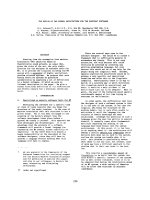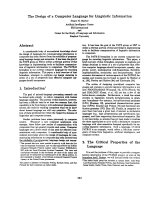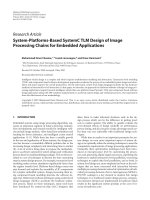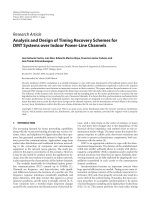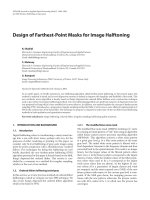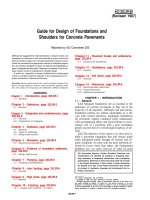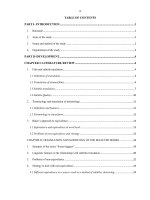Design of english electronic lectures for teaching chapter electromagnetic induction, physics 11th grade.
Bạn đang xem bản rút gọn của tài liệu. Xem và tải ngay bản đầy đủ của tài liệu tại đây (3.12 MB, 107 trang )
THE UNIVERSITY OF DANANG
UNIVERSITY OF EDUCATION
FACULTY OF PHYSICS
NGUYEN THI HONG CHI
DESIGN OF
ENGLISH ELECTRONIC LECTURES
FOR TEACHING CHAPTER
ELECTROMAGNETIC INDUCTION,
PHYSICS 11th GRADE
BACHELOR THESIS
Da Nang, 2018
THE UNIVERSITY OF DANANG
UNIVERSITY OF EDUCATION
FACULTY OF PHYSICS
NGUYEN THI HONG CHI
DESIGN OF
ENGLISH ELECTRONIC LECTURES
FOR TEACHING CHAPTER
ELECTROMAGNETIC INDUCTION,
PHYSICS 11th GRADE
BACHELOR THESIS
Major : Physics Teacher
Cohort: 2014 - 2018
Supervisor: Dr. NGUYEN QUY TUAN
Da Nang, 2018
ACKNOWLEDGEMENTS
In completion of my thesis, I have received generous advice and help from
many people whose lectures are very practical and useful. With deep respect and
gratitude, I would like to express my sincere thanks to:
Teachers in the Faculty of Physics, University of Education - the University of
Da Nang has taught, helped me equip the necessary and precious knowledge.
Dr. Nguyen Quy Tuan who is my supervisor has guided and helped generously
me in the process of completing my thesis.
Finally, I would like to thank my family, my friends, who always care and
encourage me.
Although, I have tried in the capacity and scope to allow myself to complete
this thesis but not avoid the shortcomings.I hope to receive the sympathy and
enthusiastic comments of teachers and friends.
I sincerely thank!
Da Nang, April 2018
Student perform
NGUYEN THI HONG CHI
I
TABLE OF CONTENTS
ACKNOWLEDGEMENTS ...................................................................................... I
SYMBOL LISTS AND ACRONYMS .................................................................. IV
LIST OF TABLES ................................................................................................... V
LIST OF FIGURES ................................................................................................. V
INTRODUCTION .....................................................................................................1
1. Rationale ................................................................................................................1
2. Aims of the study ...................................................................................................2
3. Research tasks .......................................................................................................2
4. Subjects and scope of the study ...........................................................................2
5. Methods of study ...................................................................................................2
CONTENTS ...............................................................................................................3
CHAPTER I: LITERATURE REVIEW AND PRACTICAL RESEARCH ......3
1.1 Theoretical background of teaching the natural sciences subjects in English .3
1.1.1.
Levels of teaching the natural sciences subjects in English ..................3
1.1.2.
The roles of teaching the natural sciences subjects in English .............3
1.2 Practical basis of teaching the natural sciences subjects in English ................4
1.3. Electronic lecture..............................................................................................5
1.3.1.
Electronic lecture concept .....................................................................5
1.3.2.
The roles of electronic lecture in teaching physics at high school........5
1.3.3.
The process of design electronic lecture for teaching ...........................6
1.3.4.
Some notes for designing electronic lectures: .......................................8
CHAPTER II: ENGLISH LESSON PLANS FOR TEACHING CHAPTER
ELECTROMAGNETIC INDUCTION, PHYSIC 11TH GRADE .....................10
2.1. Structural and content analysis of the “Electromagnetic induction”: ............10
2.1.1.
Features chapter: .................................................................................10
2.1.2.
Task of the chapter: .............................................................................10
2.1.3.
Schema logic content knowledge of the chapter: ................................11
2.1.4. Standard the knowledge, skills of the chapter “Electromagnetic
induction” ..........................................................................................................11
2.2. Design the process of teaching electronic lecture in the chapter
“Electromagnetic induction”: ................................................................................12
II
2.2.1.
Objectives: ...........................................................................................12
2.2.2.
Lesson structure: .................................................................................12
2.2.3.
Specific teaching process: ...................................................................13
2.2.3.1. Magnetic flux. Electromagnetic induction ..........................................13
2.2.3.2. The induced electromotive force .........................................................30
2.2.3.3. Self-induction ......................................................................................39
CHAPTER
III:
ELECTRONIC
LECTURES
ON
CHAPTER
th
“ELECTROMAGNETIC INDUCTION” PHYSIC 11 GRADE .....................47
3.1. Some electronic lectures on chapter “Electromagnetic induction” Physic 11th
grade ......................................................................................................................47
3.1.1.
Magnetic flux. Electromagnetic induction ..........................................47
3.1.2.
The induced electromotive force .........................................................72
3.1.3.
Self-induction ......................................................................................84
3.2. The rubric to evaluate the quality of electronic letures ..................................93
CONCLUSION AND RECOMMENDATION ....................................................96
1.
Conclusion: ......................................................................................................96
2.
Recommendation: ...........................................................................................96
REFERENCES ........................................................................................................98
III
SYMBOL LISTS AND ACRONYMS
Serial
1
2
3
4
Acronym
EMF
(C)
DC
AC
Contents
Electromotive force
Closed circuit
Direct current
Alternating current
IV
LIST OF TABLES
Serial Table
Contents
1
Table 1 Standard of knowledge, skills of the
chapter “Electromagnetic induction”
Page
11
LIST OF FIGURES
Serial Figure
1
Figure 1
2
3
Figure 2
Figure 3
4
5
6
Figure 4
Figure 5
Figure 6
Contents
Schema logic content knowledge of
the
chapter
“Electromagnetic
induction”
Magnetic flux
Cross work of “Magnetic flux.
Electromagnetic induction”
Key of cross work
Work search
Key of work search
V
Page
11
15
20
20
23
24
INTRODUCTION
1. Rationale
In the world, many countries have chosen English as their second language. In
keeping with the development of the times, in addition to implementing the project
of teaching and learning foreign languages in the national education system, the
Ministry of Education and Training encourages schools to have bilingual classes in
science subjects such as Math, Chemistry, Physic…
Improving English language skills in English for high school students will
help students improve their knowledge, research, make good use of opportunities
and be able to think scientifically.
Through advanced English teaching, the knowledge and teaching capacity of
upper secondary school teachers are increasingly advanced, with access to the
knowledge that advanced countries are teaching. Therefore, the project “Teaching
and learning foreign languages in the national education system in the period 2008 –
2020” was approved by the Prime Minister on 30/9/2013. This is to aim at
comprehensively renovating the teaching and learning of foreign languages in the
national education system, implementing new curricula and teaching programs at all
levels. It is expected that by 2015, a significant progress will be made in the level of
proficiency in the use of foreign languages in human resources, especially in some
priority areas. By 2020, most of Vietnamese youths graduating from secondary
schools, colleges and universities have the ability to speak foreign languages
independently, confidently in communication, learning, working in an integrated,
multilingual and multicultural environment; Foreigns languages become the
strength of the Vietnamese people, serving the progress of industrialization and
modernization of the country [9].
However, science teachers in general English and physics in particular are
facing many difficulties, such as program-oriented issues, learning materials,
methods and forms of organization. To help teachers have an overview of materials
search, composition, teaching and research for students, to effectively teach physics
in high school curricula in English.
1
Starting from the above reasons, I chose the topic: “Design of English
electronic lectures for teaching chapter “Electromagnetic induction”, Physics 11th
grade to research.
2. Aims of the study
Design of English electronic lectures for teaching chapter “Electromagnetic
-
induction”, Physics 11th grade to develop foreign language skills for students.
Design of English lesson plans for teaching chapter “Electromagnetic
-
induction”, Physics 11th grade
-
Design study card and consolidation exercise.
-
Evaluate the quality of electronic lectures.
3. Research tasks
-
Research the theoretical and practical basis of the topic.
-
Design of English electronic lectures for teaching chapter “Electromagnetic
induction”.
4. Subjects and scope of the study
-
The content of the chapter “Electromagnetic induction” in Physics 11th grade
and similar content in English.
-
Research scope: Chapter “Electromagnetic induction” in Physics 11th grade.
5. Methods of study
-
Theoretical research method: Research related material to the topic.
-
Practical research methods: Rubric.
-
Consult expert
.
2
CONTENTS
CHAPTER I: LITERATURE REVIEW AND PRACTICAL RESEARCH
1.1 Theoretical background of teaching the natural sciences subjects in
English
1.1.1. Levels of teaching the natural sciences subjects in English
Teaching science in English is beneficial to the development of the brain of
students, helping them to have better memory, better concentration, and the ability
to get rid of irrelevant information. Where English is not the mother tongue,
teaching science in English is carried out gradually by three levels:
- Level 1: Teachers provide some Physics terms in English for students. Then
teachers teach in the classroom, communicate mainly in Vietnamese. In this way,
students will not be able to develop important skills in learning English, such as
speaking, writing and communication skills.
- Level 2: Bilingual teaching - simultaneous 50% English and 50%
Vietnamese. This approach is often used in complex situations, which are too new
for students to catch up and fail to grasp the content of the problem.
- Level 3: Teaching and organizing activities entirely in English.This method
is often used when the level of students is the same and the content is not too
complicated but relatively familiar with the students. By maximizing the use of this
method, students will have the opportunity to improve their English language skills
[2].
1.1.2. The roles of teaching the natural sciences subjects in English
English is an international language widely used in wide variety of fields
including science, technology and education. Therefore, English is a tool for us to
access advanced education and modern science and technology. Vietnam is a
developing country and international integration which help us to improve the
efficiency of education and training, exchange and apply advanced technologies in
the world.
3
Teaching physics and natural sciences in English at high school that is a
strategic direction that will help solve the high demand for quality human resources
in the coming years [5].
1.2 Practical basis of teaching the natural sciences subjects in English
In the current socio-economic context, Vietnam is gradually integrating into
the world. In particular, the ASEAN Economic Community established on
December 31st 2015, has brought more opportunities and challenges than ever for
Vietnam in general and our country’s education in particular to train generations.
The
youth have the ability to study and work in the international
environment. Therefore English plays an important role.
Based on the results of the survey of 148 high school students in schools in Da
Nang City with the theme "Students' interest in learning bilingual EnglishVietnamese language", most of the students look forward to traveling and a small
number of students preparing to study abroad in developed countries using English
as the United Kingdom, the United States. Thus, teaching science in English is very
necessary, helping students increasingly closer to the world science. Most of the
students now aware of English play a very important role since their English
learning motivation are based on their own orientation.
From the 2011 – 2012 school year, the teaching Math and the natural sciences
subjects in English has been implemented in some high schools but it has some
difficulties. First, it is difficult for teachers:
Firstly, the capacity of foreign language teachers is still low, not meeting the
demand for teaching bilingual teaching in schools. Most teachers graduated from
the majors in Vietnamese, new English skills. Grade A, B, C according to
Vietnamese standard or based on self-study and self-improvement. The
environment of foreign language interaction of teachers, many place almost no, so
the deployment of bilingual teaching became a difficult problem, heavy with them.
Secondly, the level of English proficiency of students in rural, urban, and
urban centers is uneven. Not to mention pupils are children of border people, islands
economic areas with special difficulties. Not all children can pronounce the
standard have a vocabulary, grammar rich to quickly access the lesson (while
4
English used in these lessons are specialized terminology). Guidance for children to
adapt and adapt to this model also need time and longer route.
Third, the standard textbook for bilingual teaching has not been officially
issued. The legal implications of bilingual teaching programs also make it hard to
fathom as there are no specific guidelines from the Ministry of Education and
Training. Most teachers have to learn, study, consult other sources of information to
develop the unit. Besides, there are still mixed opinions in evaluating the quality of
translation of textbooks for this work [4].
In recent years, there has been an urgent need for teaching science in English,
so some authors have studied the subject:
Pham Kim Chung has studied the topic: “Organizing the teaching of natural
sciences in English for high school students”. Presentation of the experimental
results of Developing a teaching and learning plan for physics for the 10th grade
students of the High School of Education Science in Hanoi in May 2017 with 26
English multiple choice questions. The effectiveness of teaching CLIL helps
students improve their ability to use English to study natural sciences; increase the
excitement, promote the positive, active, improve the quality of teaching [3].
Physics Classes in bilingual English - Vietnamese Optical part, grade 11
Physics by Le Hang [11]; Design electronic lecture bilingual English-Vietnamese
chapter “Direct current”, Physics 11th grade by Nguyen Thi Hop [4], etc.
Teaching Physics in English A Continuing Professional Development for NonNative English-Speaking Teachers in Thailand by Chaninan Pruekpramool [8].
1.3.
Electronic lecture
1.3.1. Electronic lecture concept
Electronic lecture is a form of classroom-based programming in which all
teaching plans are programmed by the teacher through a multimedia environment
created by the computer [5].
1.3.2. The roles of electronic lecture in teaching physics at high school
The most convenient environment for conducting electronic lectures is the
multimedia classroom equipped with computers, projectors, audio-visual
5
equipment. Besides using modern teaching methods, it should be combined with
traditional media such as blackboard, white powder. There are many problems
involved in calculating, so many teachers can write on the board so students can
understand better. When teaching by eLearning requires teachers to invest more.
But once it is put into use, the correction and addition will be easier, students are
better known. Students can be copied to install to the home for reference if the
article is posted on the students, colleagues can refer to research, comments.
Other way, Physics is an experimental science, so in teaching Physics,
experimenting is a very important part that not only increases the attractiveness of
the subject, but also helps students understand the deeply theory. But more
important is to give students a visual acumen. However, in a class with limited time,
experiment apparatus and experiments are difficult to observe with the naked eye,
the use of virtual experiments, flash, video, images are integrated in the electronic
lecture is very effective for teaching Physics in high school.
Thus, electronic lecture has very important role in teaching Physics, providing
knowledge and useful materials for teaching.
1.3.3. The process of design English electronic lecture for teaching
Step 1. Determine the purpose and requirements of the electronic lecture
The goal here is the learning objective, not the instructional goal. We are
reading textbooks, incorporating local and foreign references to understand the
content and purpose of each item in the lesson. On that basis, determine the target of
the whole lesson about knowledge, skills and attitudes. That is the goal of the
lesson.
Step 2. Select basic knowledge, focus, generalization, and high filtering to
organize them into slides
This is an important step in expressing the whole contents of the lecture. The
contents of the slides should be really distilled from the basic knowledge of each
chapter, item and paragraph. The amount of information contained in a slide is not
much, so the teacher must have synthesized and generalized thinking to select and
filter the most basic knowledge into the slide. This step, teachers do well, the
electronic lecture plan will ensure knowledge transfer.
6
Step 3. Collection of material related to the content, construction of
documentation
In addition to the collection of materials to supplement and expand knowledge
from books and related reference materials; it is important and necessary to build a
documentation store. This is a necessary condition for effective exploitation of the
PowerPoint software program, the more abundant the archives, the higher the
possibility of exploitation, the more diverse.
Sources for teachers to collect documentation:
- Information on the Internet: This is really a huge information store, we can
search information by topic. By search engines, we go to the website related to the
topic to find.
- The information on the CD-ROM, VCD: Now the information on the CDROM and VCD is very rich, can select the necessary information for the content of
the lecture to enter the archives.
In addition, the pictures and information related to the content of the lecture
are very rich can be an important source for us to add to the archives.
Step 4. Develop scripts for electronic lecture plans:
This is an important step in the design of the lecture. The construction script
must ensure the principles of pedagogy and contents of basic knowledge of the
lecture, meeting the set objectives and requirements.
Discovering and exploiting the strengths of PowerPoint to enhance the
activeness of cognitive processes in learners’ learning activities.
Construction scenarios depend on the products that are available in the
archives. Teachers need to make the right choice to build quality scripts.
Step 5. Select the language or demonstration software to build the electronic
lecture.
Once the materials are available, the basic knowledge is selected the teacher
needs to select the language and the demonstration software to conduct the
electronic lectures. Depending on the specific content that information on each slide
can be text, graphics, pictures, sound and video. The text should be brief, dynamic.
7
Use a common, simple font; the color of the text is uniform. Presentations should
use block diagrams so that participants can immediately see the logical structure of
the content to be presented.
For each lecture should use the frame, the background color uniform for the
slide. Limit the use of too bright or contrasting colors. On the other hand, it should
not be too much to use the demonstration software in a "flying" manner to attract
unnecessary curiosity for learners, dispersing the students' attention. It is important
to use the demonstration software to focus on the core content, to fully exploit the
underlying ideas within the demonstration audience by addressing issues,
guidelines, and organization. Develop cognitive to develop the thinking of the
learner.
Finally, make the link between the slides logically. This is an important work
that creates the advantages of electronic lecture so we need to maximize the linking
ability, thanks to this linking ability that the lecture is organized flexibly to help
students acquire the knowledge.
Step 6. Run the program, repair and finish.
After the design is completed, they must be run and check, especially the link
to carry out repairing and finishing.
1.3.4. Some notes for designing electronic lectures:
The color of the background: Teachers should follow the principle of contrasts
the slideshow will be more prominent. For example, when we use dark
backgrounds, we use only bright or white text. In contrast, we use only bold text
(black, dark blue, dark red, etc.) on a white or bright background.
Fonts: Fonts should be bold, clear and neat. We are using basic fonts such as
Times New Roman and Arial of Unicode or VNI-times of VIN-Windows.
Size: Select the appropriate font size, the font size of the title is usually 32, the
normal letter is 28.
Layout content: Teachers should not overlay the background image from top
left down to left, which should leave space evenly on both sides and in the
8
appropriate proportion (usually 1/5), to ensure aesthetics, sharpness and no loss of
detail when projected onto the screen.
In addition, the pictures, photos or clips may be good, but they are faint we
should not be used because it does not provide the information specified as desired.
9
CHAPTER II: ENGLISH LESSON PLANS FOR TEACHING CHAPTER
ELECTROMAGNETIC INDUCTION, PHYSIC 11TH GRADE
2.1. Structural and content analysis of the “Electromagnetic induction”:
2.1.1. Features chapter:
The "Electromagnetic Induction" chapter is the fifth chapter in the Basic
Physics Class 11 program. This chapter includes 7 periods: 4 theoretical periods, 2
exercises periods and 1 test.
Electromagnetic induction is one of the most fundamental phenomena of
electrodynamics. This phenomena study is not merely a study of phenomena, but
also the accumulation of knowledge that assures the deep understanding and
understanding of the physical applications of phenomena to life and technology. It
can be said that students can only grasp the principle of producing alternating
current, the principle of AC and DC generators, ... when students understand the
nature of the phenomenon of electromagnetic induction and the rules governing this
phenomenon. Moreover, the study of phenomena is based on the knowledge of the
phenomenon of electromagnetic induction has been studied before, so once again
help students can understand the knowledge. Based on this electromagnetic
induction, one can explain the presence of electromotive force in a moving wire
segment that cuts off magnetic induction lines, explains the inductance phenomenon
as well as the output, Foucault current, ...
The learning process of the knowledge in this chapter requires and allows
students to become acquainted with the specific cognitive methods of physics, in
particular the empirical method.
Together with the effect to help students master the phenomena, concepts,
laws and physical principles of the application, the chapter "Electromagnetic
induction" is also a means to practice skills, brain and limbs, thereby broadening the
basic understanding while promoting the creative capacity of students.
2.1.2. Task of the chapter:
Learn about the phenomenon electromagnetic induction, concepts, laws, and
applications related to this phenomenon.
10
2.1.3. Schema logic content knowledge of the chapter:
Figure 1 Schema logic content knowledge of the chapter “Electromagnetic
induction”
2.1.4. Standard the knowledge, skills of the chapter “Electromagnetic
induction”
THEME
LEVELS NEEDED
a) The phenomenon Knowledge:
of
electromagnetic -
Experimental
discription
of
the
phenomenon
induction. Magnetic electromagnetic induction.
flux. The induced - Write the formula of calculating the magnetic flux passing
electromotive force. through area. Discribe ways to change magnetic flux.
- Speech Faraday’s law of electromagnetic induction, Lenz’s
law of induced current and write the formula: c
b) The phenomenon - State the Foucault current.
11
t
of
self-induction. - State the phenomenon of self-induction.
Self-induced
- State self-induction and the unit of self-induction.
electromotive force. - State the magnetic field energy of a self-induced solenoid
Self-induction.
and every magnetic fields carry energy.
Skills:
- Do experiment on electromagnetic induction.
c)
The
magnetic
field energy of a
- Calculate the electromagnetic induction in the case of
magnetic flux through a closed circuit that changes over time.
self-induced
- Determine the direction of the induced current according to
solenoid.
Lenz's law.
- Calculate the self-induced electromotive force in the
solenoid when the current passing through it has the intensity
varying over time.
Table 1 Standard of knowledge, skills of the chapter “Electromagnetic induction”
2.2.
Design the process of teaching electronic lecture in the chapter
“Electromagnetic induction”:
2.2.1. Objectives:
By studying this chapter you should get to understand the nature of the two
kinds of electromagnetic induction, the differences between them and their common
features. To demonstrate this understanding you should be able to explain the
principles of electromagnetic induction and discuss examples of each of the two
types.
2.2.2. Lesson structure:
-
Electronic lectureis entirely in English: content, images, videos are in English.
-
Vocabulary, handouts with relevant questions and problems provided by the
teacher at the previous lesson.
- Teacher delivers content in English.
- The exercises are compiled in English.
12
2.2.3. Specific teaching process:
2.2.3.1.
Magnetic flux. Electromagnetic induction
UNIT 23:
MAGNETIC FLUX. ELECTROMAGNETIC INDUCTION
(Period 1)
A.
OBJECTIVES:
1. Knowlegde: Students will be able to:
-
Write the formula and understand the physical meaning of the magnetic flux.
-
Understand the concept the phenomenon of electromagnetic induction.
2. Skills:
-
Solve exercises related to flux and electromagnetic induction.
-
Translate some main vocabulary into Vietnamese:
+ Induce/ produce
+ Electric current/ Electricity
+ Magnet/ Magnetic field/ Magnetic field lines/ Magnetic flux
+ Initial magnetic field/ final magnetic field
+ Electromagnetic induction
+ Experiment
+ A closed circuit/ Battery/ Galvanometer
+ Wire/ a loop/ a coil/ a soleniod
+ Direction
+ Intensity
+ Induced current/ induced voltage
+ Right hand rule
3. Attitude:
-
Positively related knowledge to reality.
13
B.
Enjoy and be active in learning professional vocabulary.
PREPARE:
1. Teacher:
-
Videos on the phenomenon of electromagnetic induction.
-
Powerpoint.
-
Study card.
STUDY CARD
UNIT 23:
MAGNETIC FLUX. ELECTROMAGNETIC INDUCTION
1. Vocabulary:
-
Induce/ produce
-
Electric current/ Electricity
-
Magnet/ Magnetic field/ Magnetic field lines/ Magnetic flux
-
Initial magnetic field/ final magnetic field
-
Electromagnetic induction
-
Experiment
-
A closed circuit/ Battery/ Galvanometer
-
Wire/ a loop/ a coil/ a solenoid
-
Direction
-
Intensity
-
Induced current/ Induced voltage
-
Right hand rule
2. Main contents:
a. The formula of magnetic flux:
The names and units of the quantities in the formula:
The unit of magnetic flux:
b. The phenomenon of electromagnetic induction:
3. The state of Lenz’s law:
4. The Foucault current:
-
Homework.
-
Table content:
14
PERIOD 44 - UNIT 23:
MAGNETIC FLUX.
ELECTROMAGNETIC INDUCTION
(Period 1)
I.
Magnetic flux:
1. Definition:
Figure 2
BS cos
With:
B: The magnitude of magnetic filed
A: Area
⃗)
α=(𝑛⃗ , 𝐵
2. The unit of magnetic flux:
In the SI system, the unit of magnetic flux is weber.
Symbol: Wb
In the formula if S = 1m2 and B = 1T, Φ = 1Wb
II. The phenomenon of electromagnetic induction:
1. Experiment:
2. Conclusion:
-
Each time the magnetic flux passing through the closed circuit (C) varies,
there is a current called inductive current in the closed circuit (C).
-
The appearance of inductive current in (C) is called the phenomenon of
electromagnetic induction.
-
The phenomenon of electromagnetic induction only exits in the time that the
magnetic flux passing through the closed circuit varies.
2. Students:
-
Review the knowledge of magnetic field.
15
C.
ACTIVITIES IN CLASS:
1. Activity 1: Information Faraday.
Michael Faraday (born Sept. 22, 1791 - die in 1867) was a British physicist and
chemist who is best known for his discoveries of electromagnetic induction and of
the laws of electrolysis. His biggest breakthrough in electricity was his invention of
the electric motor. In Faraday's first experimental demonstration (August 29, 1831),
he wrapped two wires around opposite sides of an iron ring or "torus" (an
arrangement similar to a modern toroidal transformer). Based on his understanding
of electromagnets, he expected that, when current started to flow in one wire, a sort
of wave would travel through the ring and cause some electrical effect on the
opposite side. He plugged one wire into a galvanometer, and watched it as he
connected the other wire to a battery. He saw a transient current, which he called a
"wave of electricity", when he connected the wire to the battery and another when
he disconnected it. This induction was due to the change in magnetic flux that
occurred when the battery was connected and disconnected.
2. Activity 2: Magnetic flux.
Teacher's activities
Students' activities
- Observe the simulated fish catcher - Observe.
slide.
- How many fishes going into the - Answer.
basket?
- What does fish going into the basket - Discuss and answer.
depend on?
- Feedback: Fishes going into the basket - Listen
depends on:
+ Surface area of the fish basket: A
+The angle between the 𝐯⃗ and the line is
perpendicular to surface area of the fish
basket: α
+ quantity of fish going: N
16
the amount of fishes going into the
basket = N.A.cosα
- How
to
express
the
number
of
magnetic field lines through a certain
area?
- Consider a plane of area A in a uniform - Listen and copy.
⃗⃗ that makes an angle 𝜶
magnetic field 𝑩
⃗ of the plane. The
with the normal 𝒏
magnetic flux Φ through the plane A:
ϕ=BScosα
- Think and answer.
- How can the magnetic flux change?
+ Only change B
+ Only change A
+ Only change α
+ Change B, A, α appropriately
- Show the video
- Observe.
- In the video, ϕ depends on B, A, α.
- Consider the different cases of : - Listen carefully.
When α = 90o then Φ = 0
α = 0 then Φ = B.S
α = 1800 then Φ = -B.S
900 <α < 1800 then Φ < 0
α < 900 then Φ > 0
The magnetic flux depends on the
⃗ , 𝑛⃗.
angle between the 𝐵
- = 00 , cos =1 max = BA
- Listen and copy.
If A = 1m2 , B = 1T , = 1 Tm2
- In the SI system, the unit of magnetic
flux is Tm2 , defined as a weber (Wb)
1Wb = 1T.1m2 = 1T.m2
- If choose S=1m2, α = 0o then Φ=B. - Magnetic flux equals the magnetic field
17
What does the magnetic flux mean?
lines through a unit area.
- For the purpose of introducing the
concept of magnetic flux, we go to the
next
section
"The
phenomenon
of
electromagnetic induction”
3. Activity 3: The phenomenon of electromagnetic induction.
Teacher's activities
Students' activities
- Show the video of the phenomenon of - Observe.
electromagnetic induction.
- Describe
the
phenomena
in
two - The
both
experiment,
the
galvanometer’s needle G deflects in
experiments?
the galvanometer there is a current i.
- Give views simulation experiments and - Observe and answer.
explain.
- Explain: Let the magnet move near or - Listen.
away from the (C), the magnetic field
lines passing through the wire coil
increase or decrease.
→ passing through the wire coil
increase or decrease.
→I≠0
- Show the video.
- Observe.
- What’s happen when we replace the - Discuss and answer.
magnet by an electromagnet?
+ When we change the current passing
through the electromagnet, the induced
current I still appear in the closed circuit.
- Conclusion:
+ Each time the magnetic flux passing - Listen and copy.
through the closed circuit (C) varies,
18

